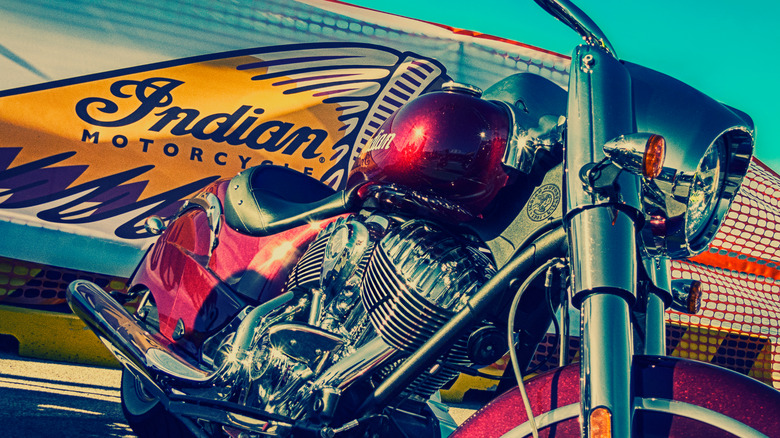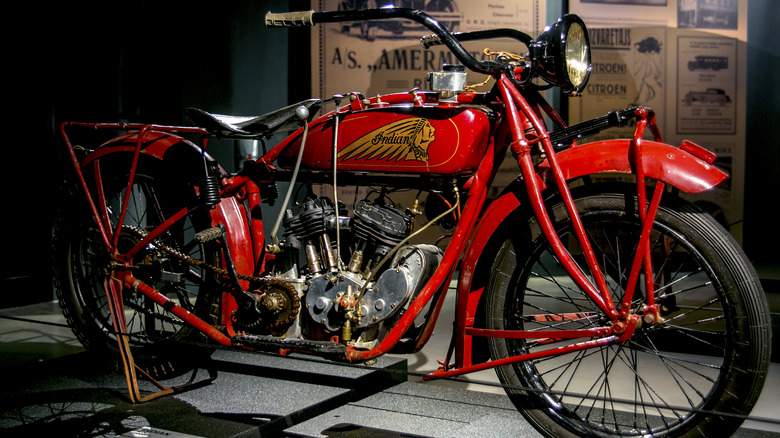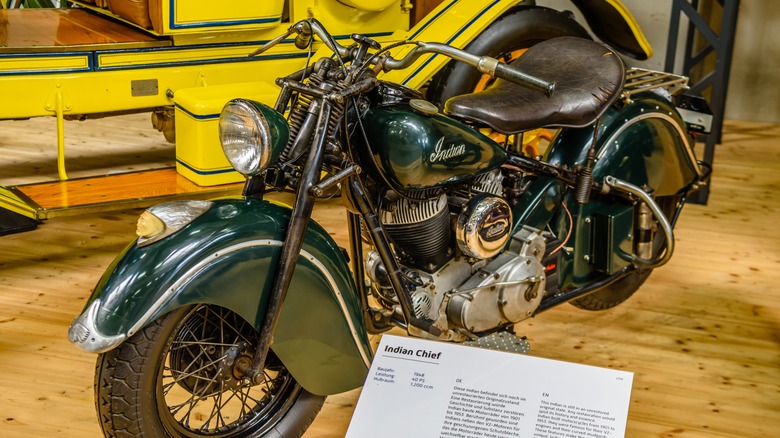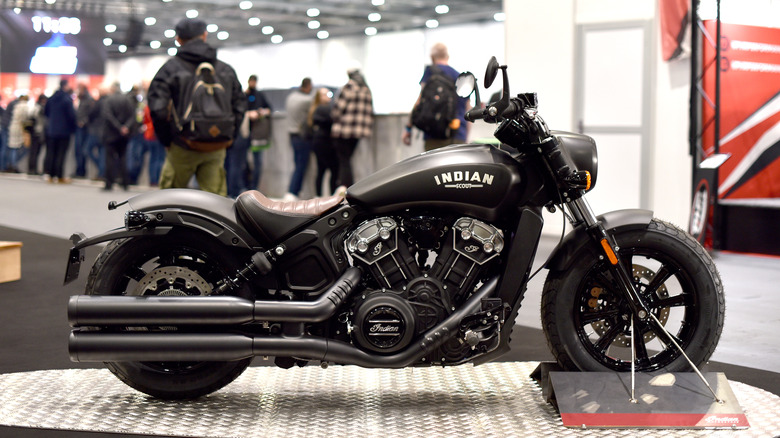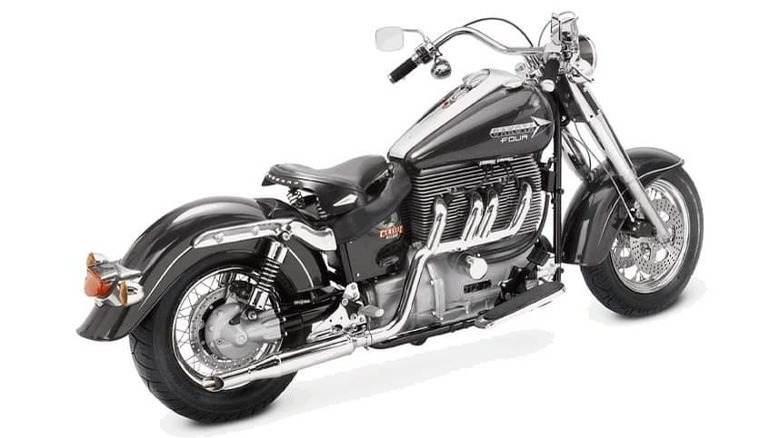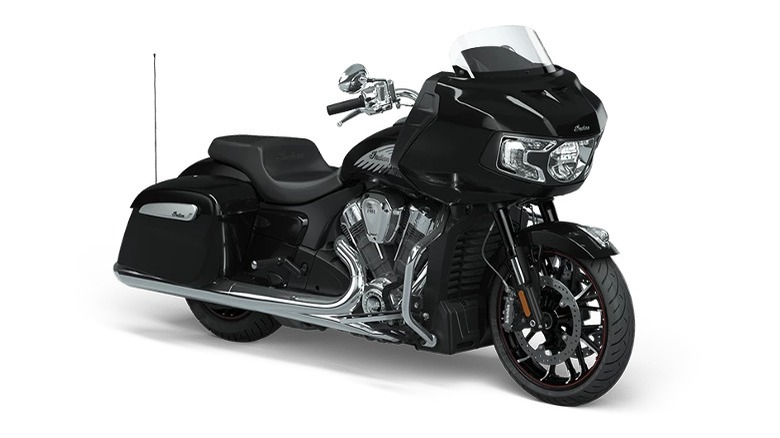5 Of The Most Underrated Indian Motorcycles Ever Made
In 2011, Indian Motorcycle made a triumphant return to the brand's former glory. Under the direction of new ownership in Polaris, the brand began to expand once again, delivering fantastic bikes to avid riders of all types. Indian is a brand that has catered to the most exacting of clients while at the same time delivering basic setups that are perfectly in tune with the needs of the beginner rider. From its beginnings at the turn of the 20th century through to the modern era of motorcycling, Indian has produced some shining examples of ingenuity and engineering.
Sadly, many of these models went on to experience lackluster support from the marketplace and remain underappreciated to this day. Looking back on the history of the brand, it might be easy to ascribe some of this middling performance to problems within the motorcycle industry on the whole, or the Indian Motorcycle brand itself. Yet, none of that changes the fact that these bikes remain as great products from a historic brand.
The vintage (or modern) Indian Scout
The Indian Scout was the company's first iconic motorbike. The classic motorcycle was introduced in 1920 with a small engine capacity and nimble handling. The bike was aimed at appealing to newer riders and those looking for a breezy roadway experience. The Scout remains a simpler motorcycle in modern iterations to maintain its status as an entry-level bike. Whether vintage or otherwise, the Scout's status as a beginner motorcycle may lead some to steer clear of it in favor of something with a bit more zip or aggressive angular design. But a vintage Indian Scout remains a fabulous bike to own, regardless of your experience behind the handlebars or the number of other bikes you already have sitting in your garage. Adding one of these to your collection is a nod to the history of motorcycling itself.
The first Scouts on the road were powered by a side-valve V-Twin engine with a 596cc displacement. Paired to its powerplant was a three-speed gearbox operated by hand actuation. The vehicle could reach a top speed of 55 miles per hour and got an estimated 50 miles per gallon. The bike was initially built in Springfield, Massachusetts. Whether you're eying an original, a vintage model from a later production year, or even a contemporary Scout (with a six-speed transmission and 100 horsepower produced through its liquid-cooled 69 cubic inch V-Twin engine), you can't go wrong!
Indian Chief
Indian Chiefs are another classic symbol of the brand's early efforts to introduce motorcycling to the masses. The Chief was first built in 1922 and was the only motorcycle built by the company after it returned to production after World War II. The Indian Chief was gifted a large V-Twin engine that offered drivers reliable pep in their daily riding. The Chief has been reborn under the new ownership of Indian Motorcycle. The Chief Vintage and Chief Classic were unveiled in 2013 and exude all of the same fantastic performance elements that made the vintage models special—albeit with a contemporary lift.
The 1922 model offered a larger platform for riders than the earlier Scout. The Indian Chief was powered by a two-cylinder, 1,000cc V-Twin engine that produced 7 horsepower. The next year, Indian would come out with the "Big Chief," which utilized a larger, 1,200cc engine. The 2023 Chief is run on a 1,811cc, air-cooled Thunderstroke 111 V-Twin engine. It produces 108 ft.-lbs. of torque. Today, the Chief models take their visual cues from the early classic, giving them an enormous aesthetic weight that shouldn't be lost on motorcyclists seeking something new for their garage.
Indian Scout Bobber
Bobber-style motorcycles are often overlooked by all but a sliver of the motorcycle market. These creations are built to exude agile performance and speed above all else. Therefore, they typically do away with some of the more burdensome stylistic elements that feature prominently on cruisers, touring bikes, and others. The Scout Bobber from Indian provides a minimal display that's situated directly between the simplified handlebar layout. As well, the bike doesn't incorporate forward fairings and utilizes a smaller footprint than might otherwise be standard for the headlamp. This creates a sleek outline for the motorcycle that some might want to immediately pass on while others can't wait to get strapped in for a ride.
The Scout Bobber is arresting, to say the least. The engine is packed tightly into its typical space, and the exhaust pipes are extremely noticeable, running along the side of the bike. It's a machine clearly built for one thing: Performance riding. The engine is a 1,133cc liquid-cooled, 60-degree V-Twin that produces 100 horsepower and 72 ft.-lbs. of torque.
The Indian Dakota 4
Indian's Dakota 4 entered the market in 1999, and its aesthetic is one of muscular driving and intense cool. In a sense, it looks a lot like a streamlined Harley-Davidson Fat Boy -– the iconic bike ridden by Arnold Schwarzenegger's character in "Terminator 2." The angular length of the bike is exactly what a rider of the '80s and '90s might be looking for in their performance machine. To match, the Dakota 4 offers a significant volume of exposed chrome detailing beneath the seat and gas tank, and the motorcycle finishes off its stylization with minimized forward detailing, really highlighting the prominence of the bike performance mechanics down below. Yet, 1999 would be a year that spelled trouble for Indian, and the bankruptcy that came just a few years later would push this classically cool motorcycle somewhat into the shadows.
The bike was powered by a four-stroke, Inline four engine that sported a measured displacement of 1,845cc. The Dakota 4 produced 74 brake horsepower and 115 lb-ft. of torque. The bike dials up the image of raw power, and its performance specs certainly deliver.
Indian Challenger Limited
The Indian Challenger Limited is a quality touring motorcycle that entered the market as a direct competitor to the Harley-Davidson Road Glide. For this reason, it sits within a niche component of the overall motorcycle marketplace. Yet, with such stiff competition from the likes of Harley-Davidson, one of the most prominent names in motor vehicles on the whole, the Challenger Limited can easily shuffle into the background of motorcyclists' attention. Even so, the bike brings considerable style elements and integrated features to the fore. Not only does the Challenger Limited offer a large forward fairing and windshield section to keep your long-distance rides comfortable and enjoyable, but there's also ample storage space in the rear side compartments and a comfortable seating and pillion layout to enhance the overall experience of touring even further.
In 2020 models, the Road Glide and Challenger Limited each come in at roughly the same price, but the Challenger Limited weighs a bit less and is powered by a slightly smaller engine. The Challenger Limited is a worthy competitor in the field of touring models, but with the prominence of Indian waxing and waning throughout the years alongside the brand's financial performance, it's easy to see why a shining example like this might be overshadowed by name recognition alone. Even so, the 1,768cc, liquid-cooled PowerPlus engine produces 122 horsepower and 128 ft.-lbs. of torque, making this a firm favorite among riders who are in on the 'secret.'
